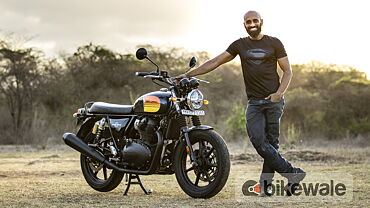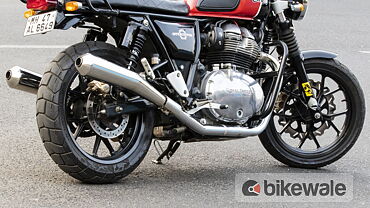Introduction

So far we have told you how the Royal Enfield Interceptor 650 feels in the city, what official accessories you should go for, and how was the service experience after the first 1,000km. Now, we have a 5,000km update for you.
In this time, there has been talk on the internet about the issues the motorcycle has had particularly regarding the fuel filler cap, rear wheel wobble, and rust. As it turns out, we haven’t had any of those issues, so we can’t really comment on them. If anything, the chrome on the crankcase has lost a bit of sheen, and the vibrations on the handlebar and the tank have increased a bit since the bike was new. This apart – all is well.
Here then is our update on what’s good and what’s not about the Interceptor 650 after having lived with it for 5,000km and six months.
What's good?
Did we mention we took the INT650 on a 2,000km road trip as part of this report? Well, we did. We rode to the south over some wide, well-paved roads; some narrow and twisty ones; and some you couldn’t call roads at all, these were more like whoops on a dirt track.

On the straight and fast, and the narrow and winding roads, the Interceptor was lovely. We could hold triple-digit speeds without a fuss. We didn’t have to bother with gear changes when overtaking – god bless the torque! And, it has great brakes too; two-finger squeeze on the front brake is all it took to come down from over 100kmph in a jiffy. Plus, there’s a good amount of power in the brakes which meant no aching right wrist even after repeated heavy usage.

It handles well too. It’s planted and stable in a straight line. And crosswinds don’t seem to get the better of it either. And, of course, it’s mostly vibe-free. So, even after 10 hours in the saddle, there are no buzzing fingers, no numb thighs, and no loose nuts and bolts to deal with.

Now around corners, it’s not as sharp or intuitive or flat as a supersports. But, it changes directions quickly. It doesn’t wallow around. And the tyres are grippy enough to allow the footpeg feeler bolts to kiss the tarmac.
There’s decent space to load luggage too if you are riding solo. The tank range of about 300km isn’t bad by any stretch. The clocks are easy to read on the move. And, the headlamps are bright enough to allow an 80kmph cruise in the dark. As you can tell, these four aspects are acceptable, but not really outstanding in any way.
What's not so good?
The Interceptor’s seat has come in for a lot of flak. And, I for one couldn’t figure why. The thing is, even after spending around two hours in the saddle on a daily basis, my butt never complained. But, as it turns out I have a pretty insensitive butt.

It took six hours of riding for me to figure out that the seat, in fact, isn’t great to spend long hours on. And, our Interceptor has the touring seat, which has denser foam compared to the stock seat. So, yes, the seat on the Interceptor won’t prove to be your behind’s best friend over long hauls.

We would have liked to see more suspension travel on the Interceptor as well. Now, the suspension works well 90 per cent of the time. It has good damping; it doesn’t bottom out easily; it doesn’t shoot you into space on rebound, and it doesn’t shudder or vibrate or collapse if the going gets tough.
However, the lack of travel meant it doesn’t cope with sudden dips and squarish bumps (like those you find when cresting poorly designed flyovers) as well as it should have. Now, the shock this transmitted didn’t knock the wind out of us, but it did push a gasp out, every time.
What's next?
In the next report, we will try and make some alterations to improve on some aspects we aren’t 100 per cent satisfied with. Take, for instance, the seating ergonomics, the suspension settings, and how the levers are positioned.

Bike Stats
Odometer: 5012km
Kilometres ridden since last report: 2898km
Fuel Efficiency: 25.8kmpl
Photography by Kaustubh Gandhi
































![KTM 390 Adventure X [2025] KTM 390 Adventure X [2025]](https://imgd.aeplcdn.com/272x153/n/cw/ec/190885/390-adventure-x-2025-right-side-view.jpeg?isig=0&q=80)